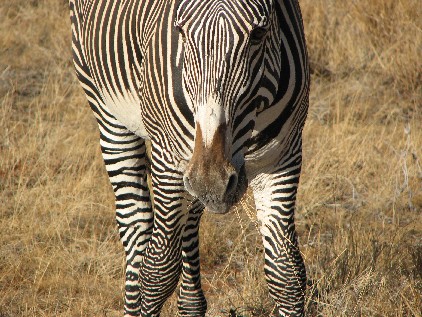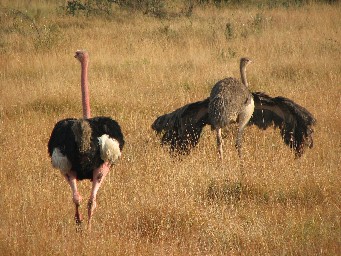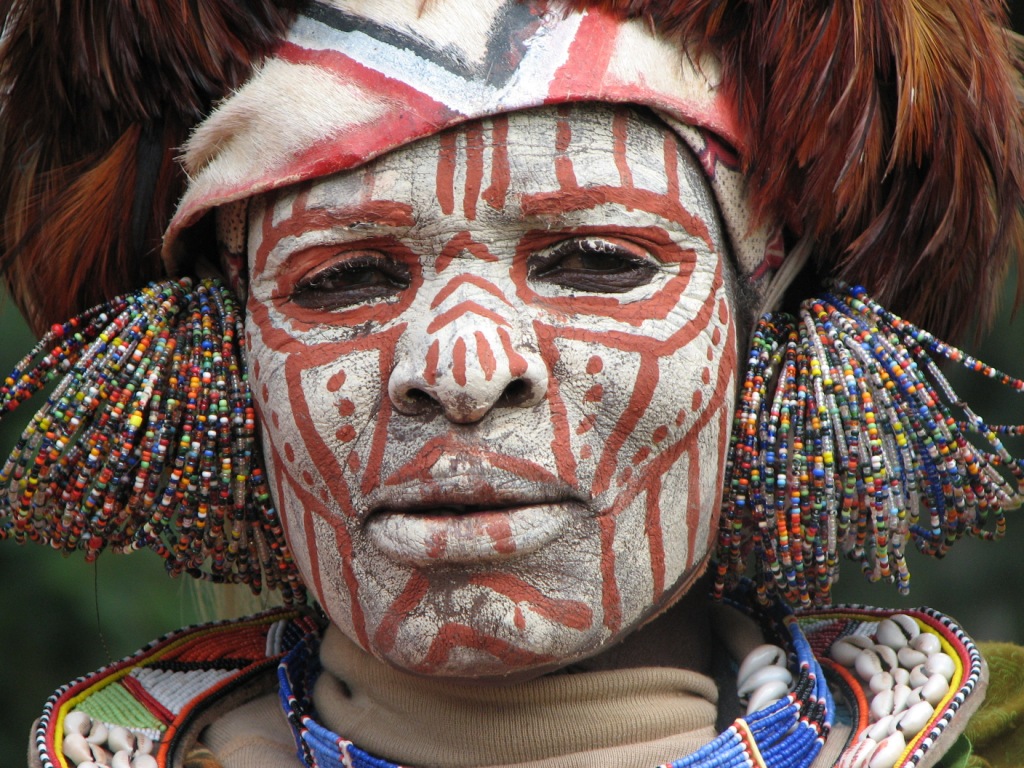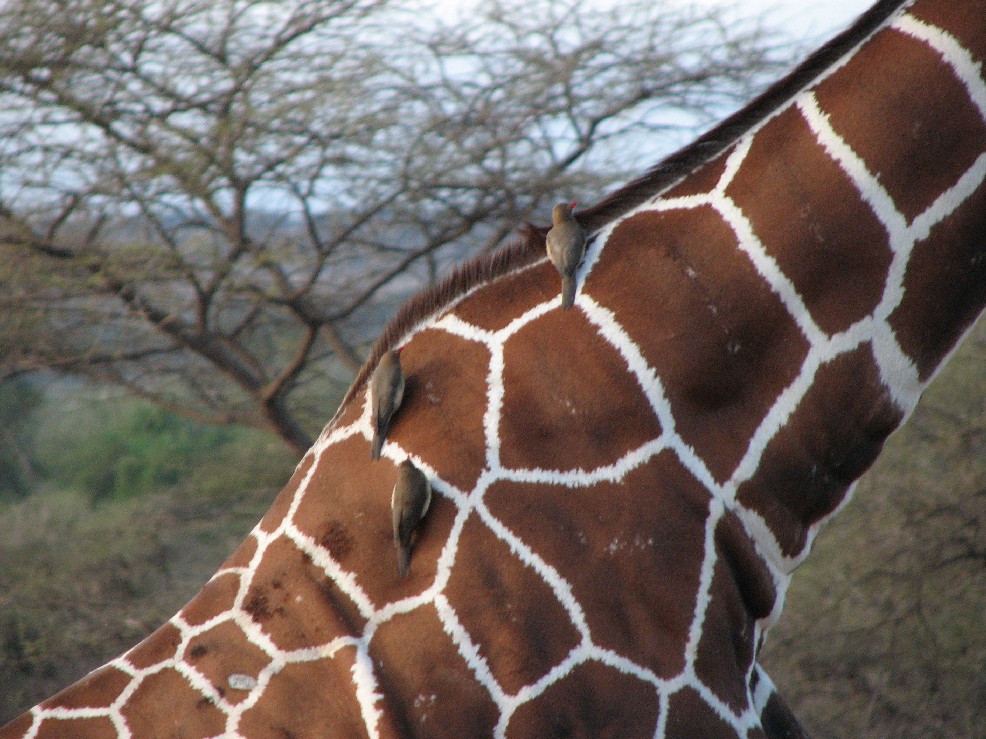We spent roughly two and a half days in Amboseli National Reserve in south central Kenya, butting up against the border with Tanzania. Our initial reactions to the area were shock at the shear amount of environmental degradation present in what is considered one of Kenya's best parks. There is a tremendous amount of erosion across the landscape here in Amboseli. Caused by rising salinization (salt accumulation in the soil due to evaporation of water on the surface), damage caused by elephants, and safari vehicles creating their own paths, the resulting area is reminiscent of the American Dust Bowl in the 1930s (except with elephants and wildebeest to name a few).
 Dust literally covers most of everything here. In fact, the wildebeest look noticeable older (grayer) here than in "the Mara". Wildlife is not hard to spot moving even hundreds of meters away. All you need to do is follow the smoke trails whisping into the air like far off smoke signals saying, "Over here!". These gray clouds are choking the remaining grasses and it is assumed that their decline will cause most of the ungulates who rely on them to move on (but where?). We even saw an interesting elephant foraging strategy here. A juvenile female would dig the dying grass with the back of her front foot, then proceed to roll it into a ball using its trunk to blow the dust off of it before eventually popping it into its mouth. It was all very well choreographed. And in the afternoon when the winds blow stronger you can see thin twisters of the gray dust shoot into the sky. This situation demands attention, but at least on the surface it appears that attention is not forthcoming. Amboseli is a hard place.
Dust literally covers most of everything here. In fact, the wildebeest look noticeable older (grayer) here than in "the Mara". Wildlife is not hard to spot moving even hundreds of meters away. All you need to do is follow the smoke trails whisping into the air like far off smoke signals saying, "Over here!". These gray clouds are choking the remaining grasses and it is assumed that their decline will cause most of the ungulates who rely on them to move on (but where?). We even saw an interesting elephant foraging strategy here. A juvenile female would dig the dying grass with the back of her front foot, then proceed to roll it into a ball using its trunk to blow the dust off of it before eventually popping it into its mouth. It was all very well choreographed. And in the afternoon when the winds blow stronger you can see thin twisters of the gray dust shoot into the sky. This situation demands attention, but at least on the surface it appears that attention is not forthcoming. Amboseli is a hard place.
 Dust literally covers most of everything here. In fact, the wildebeest look noticeable older (grayer) here than in "the Mara". Wildlife is not hard to spot moving even hundreds of meters away. All you need to do is follow the smoke trails whisping into the air like far off smoke signals saying, "Over here!". These gray clouds are choking the remaining grasses and it is assumed that their decline will cause most of the ungulates who rely on them to move on (but where?). We even saw an interesting elephant foraging strategy here. A juvenile female would dig the dying grass with the back of her front foot, then proceed to roll it into a ball using its trunk to blow the dust off of it before eventually popping it into its mouth. It was all very well choreographed. And in the afternoon when the winds blow stronger you can see thin twisters of the gray dust shoot into the sky. This situation demands attention, but at least on the surface it appears that attention is not forthcoming. Amboseli is a hard place.
Dust literally covers most of everything here. In fact, the wildebeest look noticeable older (grayer) here than in "the Mara". Wildlife is not hard to spot moving even hundreds of meters away. All you need to do is follow the smoke trails whisping into the air like far off smoke signals saying, "Over here!". These gray clouds are choking the remaining grasses and it is assumed that their decline will cause most of the ungulates who rely on them to move on (but where?). We even saw an interesting elephant foraging strategy here. A juvenile female would dig the dying grass with the back of her front foot, then proceed to roll it into a ball using its trunk to blow the dust off of it before eventually popping it into its mouth. It was all very well choreographed. And in the afternoon when the winds blow stronger you can see thin twisters of the gray dust shoot into the sky. This situation demands attention, but at least on the surface it appears that attention is not forthcoming. Amboseli is a hard place.There is a large wetland system (Lake Amboseli & others) throughout the park. It takes up a rather large area during the rainy season and shrinks to a series of small pockets (swamps) during the dry months. Here is the best place to see wildlife galour of all shapes and sizes, colors, and adaptations. Wetlands are highly productive ecosystems capable of supplying sustenance  and water to high numbers of resident and nomadic animals (including humans). Hippos graze through the muck, cattle egrets perched on their backs waiting for their free ride to turn
and water to high numbers of resident and nomadic animals (including humans). Hippos graze through the muck, cattle egrets perched on their backs waiting for their free ride to turn  something good up. Fish eagles, jacanas, plovers, wildebeest, cape buffaloes, elephants, and hundreds of other species rely on this area. Here, more than the surrounding areas, the web of life is solid and multifaceted, but it is only as resilient as the supply of water. This dwindling arc of life support is the hope of thousands of creatures for survival in this harsh, nebulous environment. In fact, a mountain across the political border with Tanzania largely determines the hydrological upkeep of the wetlands in Amboseli.
something good up. Fish eagles, jacanas, plovers, wildebeest, cape buffaloes, elephants, and hundreds of other species rely on this area. Here, more than the surrounding areas, the web of life is solid and multifaceted, but it is only as resilient as the supply of water. This dwindling arc of life support is the hope of thousands of creatures for survival in this harsh, nebulous environment. In fact, a mountain across the political border with Tanzania largely determines the hydrological upkeep of the wetlands in Amboseli.
 and water to high numbers of resident and nomadic animals (including humans). Hippos graze through the muck, cattle egrets perched on their backs waiting for their free ride to turn
and water to high numbers of resident and nomadic animals (including humans). Hippos graze through the muck, cattle egrets perched on their backs waiting for their free ride to turn  something good up. Fish eagles, jacanas, plovers, wildebeest, cape buffaloes, elephants, and hundreds of other species rely on this area. Here, more than the surrounding areas, the web of life is solid and multifaceted, but it is only as resilient as the supply of water. This dwindling arc of life support is the hope of thousands of creatures for survival in this harsh, nebulous environment. In fact, a mountain across the political border with Tanzania largely determines the hydrological upkeep of the wetlands in Amboseli.
something good up. Fish eagles, jacanas, plovers, wildebeest, cape buffaloes, elephants, and hundreds of other species rely on this area. Here, more than the surrounding areas, the web of life is solid and multifaceted, but it is only as resilient as the supply of water. This dwindling arc of life support is the hope of thousands of creatures for survival in this harsh, nebulous environment. In fact, a mountain across the political border with Tanzania largely determines the hydrological upkeep of the wetlands in Amboseli. The water that supplies the wetlands here is heavily subsidized by snow melt from Mount Kilimanjaro which slowly makes it way through subterranean rivers, trickling out into this oasis. As many of you may already be aware, the amount of snow on Kilimanjaro has been steadily declining for at least the last thirty years. A simple math equation of annual accumulation minus annual melt off shows this trend year after year. There may even be a time when there is no snow garnishing the top of Africa's highest peak.
The water that supplies the wetlands here is heavily subsidized by snow melt from Mount Kilimanjaro which slowly makes it way through subterranean rivers, trickling out into this oasis. As many of you may already be aware, the amount of snow on Kilimanjaro has been steadily declining for at least the last thirty years. A simple math equation of annual accumulation minus annual melt off shows this trend year after year. There may even be a time when there is no snow garnishing the top of Africa's highest peak.
What is causing this to happen?, you might ask. Popular scientific thought is that the steady rising of earth's annual temperatures, global warming, is the cause. And as an extension of that, we as individuals, groups, companies, and nations are heavily subsidizing this effect. So, in essence, we are all involved (whether we like it or not, we have no choice) in the fate of the hundreds of species of wildlife that call Amboseli National Reserve home. Indeed, the web of life reaches everywhere.

Nevertheless, over 350 bird species and 65 mammal species call Amboseli home. I could easily spend weeks here just looking for birds. My favorite for some reason it the Blacksmith Plover, a medium sized, black and white plover who boastfully walks by themselves or with a mate near  the water's edge. We saw our first adult male lion, who at the time was courting a lovely lioness. Cats are cats across the board and do a very good job of laying around for long periods of time. Well, at least you can get great photos of them in action (or rather inaction).
the water's edge. We saw our first adult male lion, who at the time was courting a lovely lioness. Cats are cats across the board and do a very good job of laying around for long periods of time. Well, at least you can get great photos of them in action (or rather inaction).
 the water's edge. We saw our first adult male lion, who at the time was courting a lovely lioness. Cats are cats across the board and do a very good job of laying around for long periods of time. Well, at least you can get great photos of them in action (or rather inaction).
the water's edge. We saw our first adult male lion, who at the time was courting a lovely lioness. Cats are cats across the board and do a very good job of laying around for long periods of time. Well, at least you can get great photos of them in action (or rather inaction).  We also were fortunate enough to have witnessed an awesome ceremony performed by male elephants not even ten meters from our vehicle. We saw a large group of elephants headed towards one of the swamps - mothers, infants, toddlers, juveniles, and a couple of larger males. It was clear who was the dominant male in the group. He was huge and he was in must (sexually available). Surely his goal was of a romantic nature as he followed behind the group of females.
We also were fortunate enough to have witnessed an awesome ceremony performed by male elephants not even ten meters from our vehicle. We saw a large group of elephants headed towards one of the swamps - mothers, infants, toddlers, juveniles, and a couple of larger males. It was clear who was the dominant male in the group. He was huge and he was in must (sexually available). Surely his goal was of a romantic nature as he followed behind the group of females. 
What proceeded was none other than a sizing up of potential suitors. You have to hand it to the smaller male because he had one huge set of proverbial tusks to stand up to the larger one. The encounter was rather gentle really. They would lock trunks slowly, push on each other, and do sort of swaying motions with tusks interlocked. But nothing violent was observed. It almost seemed like a friendly arm wrestling match between friends, although replace trunks and tusks for arms. They eventually sorted things out, the smaller one submitting himself to the larger one by turning around with his rear end exposed, and then continued on their way. Ask Jessica how many photos she took when you get a chance.
 We said goodbye to Amboseli and headed back to Nairobi retracing the bumpy roads one by one. Our safari had come to a close and it was amazing. I encourage anyone in need of adventure to come and experience the ride of a lifetime.
We said goodbye to Amboseli and headed back to Nairobi retracing the bumpy roads one by one. Our safari had come to a close and it was amazing. I encourage anyone in need of adventure to come and experience the ride of a lifetime.
 We said goodbye to Amboseli and headed back to Nairobi retracing the bumpy roads one by one. Our safari had come to a close and it was amazing. I encourage anyone in need of adventure to come and experience the ride of a lifetime.
We said goodbye to Amboseli and headed back to Nairobi retracing the bumpy roads one by one. Our safari had come to a close and it was amazing. I encourage anyone in need of adventure to come and experience the ride of a lifetime.There certainly is something magical and inspiring about the landscape in Amboseli. I challenge anyone to look at a sunset here and not claim it in their top five places to see the daily event. It is noticeably so old and weathered here yet so may animals continue to eke out an existence, weaving their way through the ropes in the web, relying on the connections between each other.














No comments:
Post a Comment